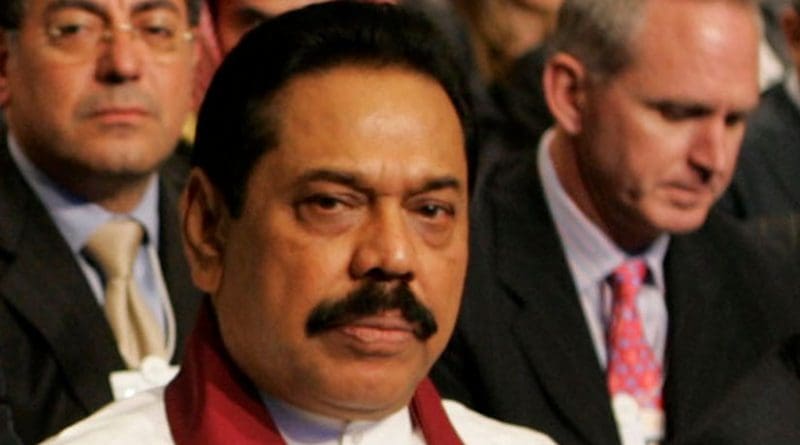Opportunities For India In Rajapaksa’s Defeat – Analysis
By Amit Dasgupta*
Psephologists got it completely wrong. But then, so did everyone else, including Mahinda Rajapaksa himself.
Indeed, he was so convinced of a third term that he called for elections two years in advance. The results stunned everyone, including Rajapaksa’s astrologer, who had assured him of victory.
For Beijing, Rajapaksa’s defeat is a serious strategic setback. They could read the signs early enough with regard to what they could expect, because in the election manifesto itself Maithripala Sirisena had voiced his disapproval of the heightened Chinese presence. He drew attention to the growing ‘foreign’ presence, which he lamented would once again reduce Sri Lanka into ‘a colony’.
During Rajapaksa’s tenure, much to India’s discomfiture, Sri Lanka brazenly taunted India by assiduously playing the China card. India had watched with growing anxiety and was clearly rattled when a Chinese submarine was provided berthing facilities within sniffing distance of its shores.
The dramatic defeat of Rajapaksa could result in President Sirisena diluting Beijing’s embrace considerably. Beijing would be watching as to how Indian Prime Minister Narendra Modi plays his cards. While Sirisena has agreed to an early India visit, a lot would depend on the sensitivity with which New Delhi responds.
First, New Delhi needs to assure Sirisena of full support without being perceived as interfering in Sri Lanka’s domestic affairs. Domestic constituencies in India will, understandably, lobby for greater rights and autonomy for the Tamil population. But for now, India needs to strongly and openly endorse Sirisena’s commitment for the ‘truth-seeking mechanism’ and ‘reconciliation’, which in itself is a huge step from the Rajapaksa era.
Second, there is genuine worry among many Sri Lankans that the Sirisena government might not demonstrate the same commitment to growth as Rajapaksa. An economically resilient Sri Lanka would be in India’s interest. With the South Asian Association for Regional Cooperation (SAARC) as good as dead, India needs to actively pursue sub-regional cooperation that could see the Maldives, Sri Lanka and the southern states of India integrated on a range of social and economic issues.
Third, India needs to candidly share its security concerns, especially on Pakistan-supported terrorism, with the new government. All indications suggest that Sirisena will be receptive to this. It would be useful to craft a mechanism through which intelligence sharing and cooperation is enhanced.
Fourth, India’s Development Partnership Administration (DPA) programme for providing development assistance needs to be streamlined if it is to be an effective foreign policy instrument. Presently, there are delays in fund disbursement and consequently, slippages in time schedules. A clear directive from the Prime Minister’s Office (PMO) can correct this. Simultaneously, focus needs to be directed on areas identified by the new government in Colombo, whether they are in infrastructure or the social sector, rather than on what New Delhi might consider as priorities.
Finally, India needs to be pragmatic. It needs to recognize that Beijing would continue to encourage the neighbourhood to invoke the China card. Further, some of our neighbours have demonstrated and will continue to demonstrate their inclination to succumb to such inducement. This is part of Beijing’s belligerent desire for assertiveness in the region, and is based on their policy of containing India through encirclement. The push for a greater role for Beijing at the recent SAARC summit clearly reflected this.
Furthermore, Sirisena will opt for policies that enhance Sri Lanka’s interests. This is as it should be. If India is to take advantage of Rajapaksa’s defeat, it can do so only if it is sensitive to Colombo’s concerns and supportive of Colombo’s interests. For the moment, New Delhi needs to take heart that Sirisena wishes to pursue a more balanced foreign policy than his predecessor.
At the same time, it is important for India to be cognizant that a long and hard road lies ahead for Sirisena. Rajapaksa’s United People’s Freedom Alliance (UPFA) enjoys a majority in parliament. Sirisena vowed, within a self-administered deadline of 100 days, to abolish the executive presidency. It has been in place since 1978 and provides the president with almost authoritarian powers. This is not going to be easy but if Sirisena can pull it off, it will win hearts and minds of those who had been severely undermined during the Rajapaksa tenure.
Granting greater autonomy to the provinces is not likely to happen overnight nor indeed is it likely to be an immediate priority. But, as Sirisena gains in popularity and strength, it needs to be an area that New Delhi can gently nudge him towards. A soft-spoken, almost shy person, Sirisena lacks the flamboyance and arrogance of Rajapaksa. It is unlikely that he would be opposed to provincial autonomy, as it would only strengthen his hand.
The time is ripe for New Delhi to do some urgent and out-of-the-box thinking on its neighbourhood policy. Opportunities, such as Rajapaksa’s stunning defeat, do not come every day.
(Amit Dasgupta is a former diplomat. He can be reached at [email protected])

